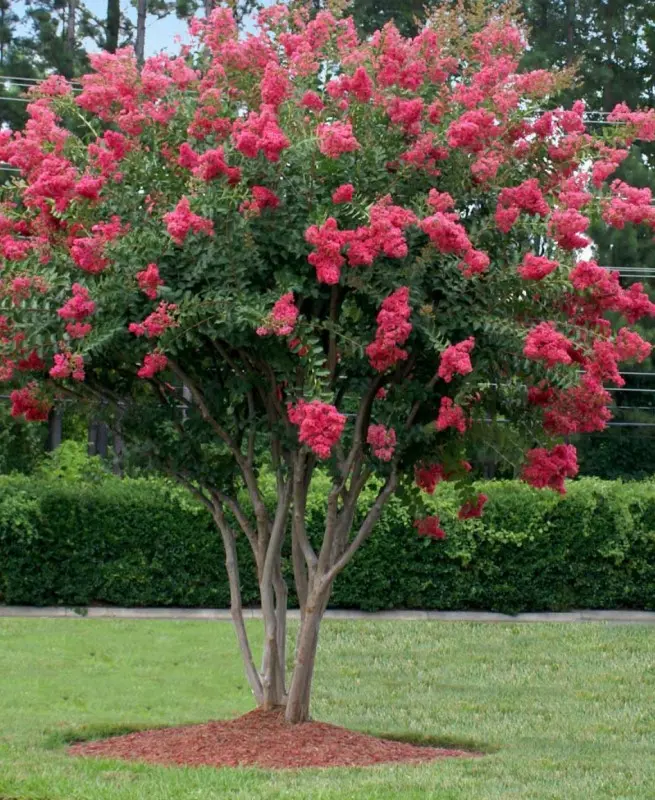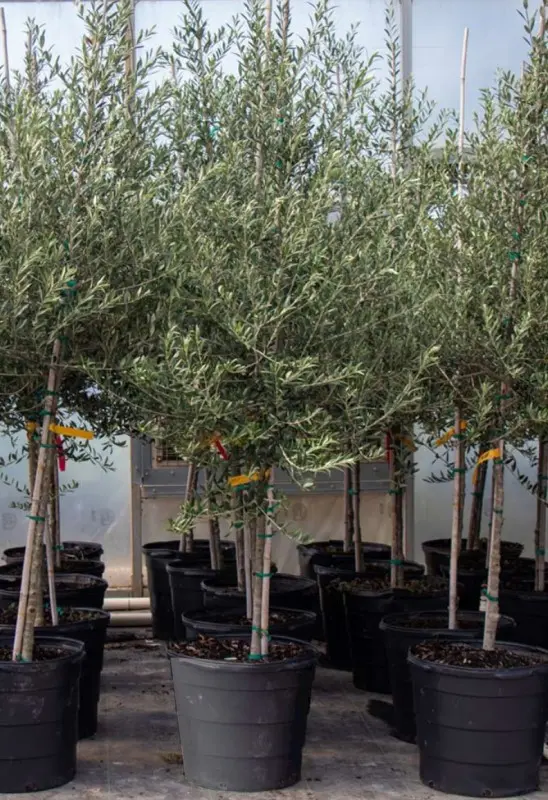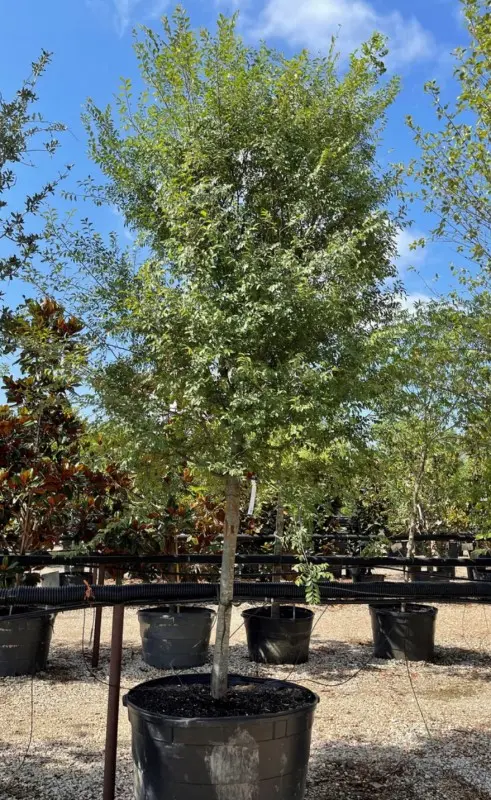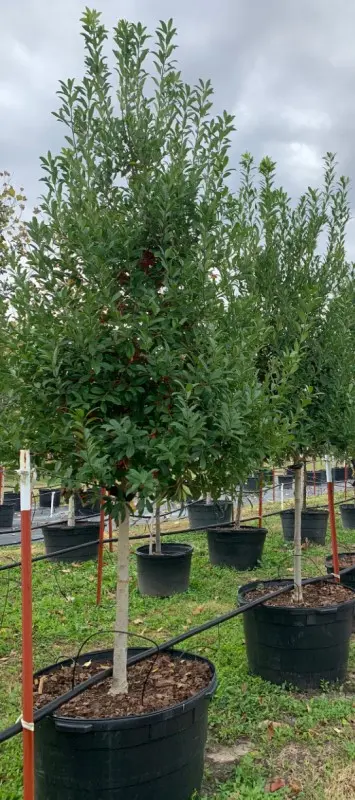-

Crepe Myrtle
$0.00
Deciduous (loses leaves in winter)
Up to 20'
Grow to 24" per year
-
Crepe Myrtle (Lagerstroemia spp.) is a beloved deciduous tree or large shrub known for its long-lasting, vibrant blooms, attractive bark, and minimal maintenance needs. Native to Asia, Crepe Myrtles are popular in warm climates for their showy clusters of flowers that bloom from late spring through early fall. Flowers appear in shades of pink, red, purple, white, and lavender, adding vivid color to landscapes over an extended season. The tree’s distinctive, smooth, mottled bark sheds in thin layers, revealing a handsome, polished look that adds interest even in winter.
Crepe Myrtles vary greatly in size, from dwarf varieties as small as 3-5 feet tall to large trees reaching 20-30 feet, depending on the species and cultivar. They thrive in USDA zones 6-10 and prefer full sun, which promotes the best bloom production and helps prevent powdery mildew. Crepe Myrtles are adaptable to various well-draining soil types, including sandy, clay, and loamy soils, and are drought-tolerant once established, making them ideal for low-water gardens.
Low-maintenance and resilient, Crepe Myrtles require only occasional pruning to remove any deadwood or to shape the tree. Pruning in late winter encourages new growth and enhances flowering. These trees are often used as ornamental focal points, in rows along driveways, or as flowering hedges in both formal and informal gardens.
With their vibrant blooms, attractive bark, and adaptability, Crepe Myrtles are a favorite for adding year-round beauty and interest to landscapes, especially in Southern gardens.
-

Olive Tree
$0.00
Evergreen
Slow growth rate
Up to 25'
-
Olive Tree (Olea europaea) is an evergreen tree native to the Mediterranean region, renowned for its silvery-green foliage, gnarled trunk, and edible fruit. Cultivated for thousands of years, Olive trees are highly valued for their olives and olive oil, as well as their ornamental beauty in landscapes. The tree’s narrow, elongated leaves are dark green on top and silvery-gray underneath, creating a distinctive, shimmering appearance. Olive trees bloom in late spring, producing small, fragrant, creamy-white flowers that give way to green fruits, which ripen to a purplish-black or dark green in late summer or early fall.
Typically growing 20 to 30 feet tall and wide, Olive trees have a slow to moderate growth rate and can live for centuries, with many specimens displaying their signature twisting, gnarled trunks as they age. They thrive in USDA zones 8-11, preferring full sun and well-draining soil with a slightly alkaline pH. Olive trees are drought-tolerant once established and can withstand hot, dry climates as well as coastal conditions, making them ideal for Mediterranean and arid landscapes. While they are frost-sensitive, certain cold-hardy varieties can withstand brief dips in temperature, allowing them to grow in slightly cooler regions.
Low-maintenance and relatively pest-resistant, Olive trees require minimal pruning, typically in late winter to early spring, to shape or control size. They are often used as specimen trees, in groves, or in pots, bringing a classic, Mediterranean aesthetic to gardens, courtyards, and patios. With their elegant foliage, historical significance, and adaptability, Olive trees add both functional and ornamental value, creating a timeless look in landscapes that recalls the warmth and heritage of the Mediterranean.
-

Leyland Cypress
$0.00
Evergreen
Grows up to 36" per year
Up to 40'
-
Leyland Cypress (Cupressus × leylandii) is a fast-growing evergreen tree widely valued for its dense foliage and adaptability as a privacy screen or windbreak. This hybrid conifer, a cross between Monterey Cypress (Cupressus macrocarpa) and Alaskan Cedar (Chamaecyparis nootkatensis), features soft, feathery, blue-green to dark green needles that maintain color year-round, providing consistent coverage and privacy in the landscape. With a naturally pyramidal shape, Leyland Cypress offers a clean, formal look and quickly grows tall enough to create a substantial barrier.
Leyland Cypress trees typically reach heights of 30 to 50 feet, though they can grow up to 70 feet in optimal conditions, with a spread of 15 to 25 feet. Known for their rapid growth, they can gain 3 to 4 feet in height each year. Hardy in USDA zones 6-10, they thrive in full sun and are adaptable to various well-draining soil types, including sandy, loamy, and clay soils. Though moderately drought-tolerant once established, they benefit from regular watering, especially during dry spells, to maintain healthy growth.
Low-maintenance overall, Leyland Cypress requires minimal pruning aside from shaping or trimming to control height and spread, especially if used as a hedge. It is important to plant them with adequate space for airflow, as they can be susceptible to fungal diseases in humid or overly crowded conditions. With its fast growth, dense foliage, and ability to create effective privacy and wind barriers, Leyland Cypress is a popular choice for homeowners and landscapers looking to quickly establish a green screen or boundary in the landscape.
-

Elm Tree
$0.00
Deciduous (loose leave in winter)
Grows up to 24" per year
Up to 35'
Elm Tree (Ulmus spp.) is a large, deciduous tree admired for its graceful, vase-like shape, broad canopy, and resilience in urban and rural landscapes. Native to Europe, Asia, and North America, elms are known for their broad, serrated, dark green leaves that turn golden yellow in the fall, providing seasonal color and shade. The tree's mature bark is rugged and deeply fissured, adding texture and character to the landscape. Common varieties include the American Elm (Ulmus americana), the Chinese Elm (Ulmus parvifolia), and the English Elm (Ulmus procera).
Elms typically grow between 60 and 80 feet tall, with a spread of 40 to 70 feet, creating a broad, arching canopy that provides ample shade. They thrive in USDA zones 4-9, depending on the species, and adapt well to a variety of soil types, including clay, loamy, and sandy soils. Elms are best planted in full sun to partial shade and benefit from well-draining, moderately fertile soil, though they are moderately drought-tolerant once established. Known for their versatility, elms are often planted as shade trees in parks, along streets, and in large residential landscapes.
In recent years, elms have been bred for increased disease resistance, especially against Dutch Elm Disease, which affected many native elms in North America. Low-maintenance overall, elms require occasional pruning to remove dead or damaged branches and maintain airflow through the canopy. With their expansive, arching forms, vibrant fall colors, and adaptability, elm trees are a timeless choice for adding shade, beauty, and structure to diverse landscapes.






